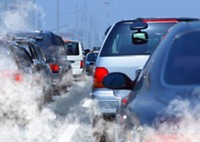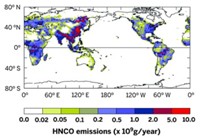Advertisement
Grab your lab coat. Let's get started
Welcome!
Welcome!
Create an account below to get 6 C&EN articles per month, receive newsletters and more - all free.
It seems this is your first time logging in online. Please enter the following information to continue.
As an ACS member you automatically get access to this site. All we need is few more details to create your reading experience.
Not you? Sign in with a different account.
Not you? Sign in with a different account.
ERROR 1
ERROR 1
ERROR 2
ERROR 2
ERROR 2
ERROR 2
ERROR 2
Password and Confirm password must match.
If you have an ACS member number, please enter it here so we can link this account to your membership. (optional)
ERROR 2
ACS values your privacy. By submitting your information, you are gaining access to C&EN and subscribing to our weekly newsletter. We use the information you provide to make your reading experience better, and we will never sell your data to third party members.
Environment
Automobiles Emit Pollutant Found In Tobacco Smoke
Air Pollution: Car exhaust contains toxic isocyanic acid
by Janet Pelley
July 18, 2013
| A version of this story appeared in
Volume 91, Issue 29

Automobile emissions are a significant source of the once-overlooked urban pollutant isocyanic acid, Canadian researchers report. The scientists estimate that city traffic releases the chemical at levels high enough to possibly trigger health problems in people (Environ. Sci. Technol. 2013, DOI: 10.1021/es401127j).
Isocyanic Acid At A Glance
Chemical formula: H–N=C=O
Boiling point: 23.5 °C
Discovery: in 1830 by German chemists Justus von Liebig and Friedrich Wöhler
Dose per cigarette: up to 108 μg; estimate based on pyrolysis of urea, a tobacco additive
Air quality standard: none in the U.S. or Canada
SOURCE: Proc. Natl. Acad. Sci. USA 2011, DOI: 10.1073/pnas.1103352108
Toxicologists have studied isocyanic acid (HNCO) in the blood of people who smoke tobacco products and linked it to health problems such as cataracts, rheumatoid arthritis, and hardened arteries. The molecule reacts with amine groups on proteins through a process called carbamylation. These modifications cause the proteins to unfold, which then triggers a damaging inflammatory response.
Atmospheric chemists have only recently started to study isocyanic acid, with the help of a new type of mass spectrometer sensitive to gaseous acids. They detected isocyanic acid for the first time in wood and tobacco smoke (C&EN, May 23, 2011, page 32). Measurements of the air around Boulder, Colo., found levels of isocyanic acid of up to 200 parts per trillion by volume. The researchers note that its presence could be attributed to nearby wildfires that were burning at the time.
“We thought that if forest fires can produce isocyanic acid, it was likely that vehicles could produce it, too,” says John Liggio, a research scientist with Environment Canada. To estimate how much, Liggio and his colleagues ran a light-duty diesel engine from a passenger car in their lab and used the acid-sensitive mass spectrometer to measure pollutants in the exhaust. They next calculated the ratio between isocyanic acid and carbon monoxide. Using data on annual carbon monoxide releases from vehicles, the researchers estimated that light-duty diesel vehicles emit roughly 6 metric tons of isocyanic acid per year across Canada.
The scientists also measured levels of the acid in the air near a major roadway in Toronto. On the basis of those measurements, they estimated that all vehicular traffic generates 770 metric tons of isocyanic acid per year throughout Canada. The large difference between the lab-based and field-based estimates suggests that “a lot more vehicles than just light-duty diesels are releasing isocyanic acid,” Liggio says.
Joost de Gouw of the University of Colorado, Boulder, who developed the technique to measure isocyanic acid, points out that the concentrations measured in Toronto’s air in 2012 spiked as high as 990 ppt by volume. That concentration approaches an amount of inhaled isocyanic acid, estimated at 1 ppb by volume, that could lead to levels in the blood that favor protein carbamylation.
“The bottom line is that we know the compound is in the atmosphere, it has potential health impacts, and we need to know more about the sources,” de Gouw says.





Join the conversation
Contact the reporter
Submit a Letter to the Editor for publication
Engage with us on Twitter